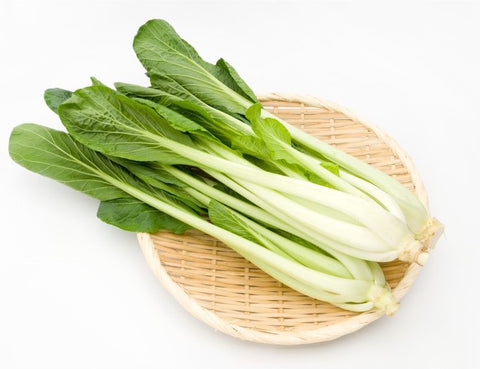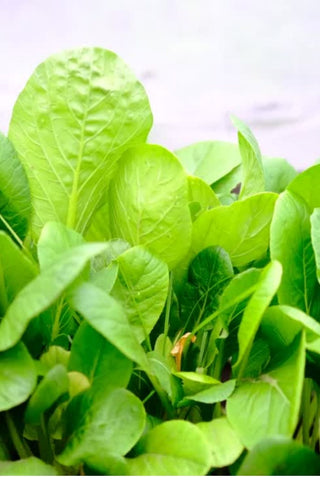Have you heard of komatsuna? Sometimes known as mustard spinach or Japanese mustard spinach, it is a very hardy leafy winter green. If you are a fan of oriental brassicas like mizuna and pak choi then you will discover that komatsuna is milder, more tender and importantly less likely to bolt in spring and autumn. A ‘must grow’ winter green.

It can be eaten as a cut and come again leaf or left to mature and eaten like a pak choi or cabbage. The good thing for growing it at home is that it is hardy and impervious to the effects of all but the worst of weather so is an ideal crop for your winter garden in cold climates.
It’s a grown in Japan since the 18th century and gets its name from the area in Tokyo near the Komatsu-gawa River. Plant breeders in Japan have had a lot of fun with it crossing it with closely related vegetables like pak choi, and Chinese cabbage to create new veg.
When to Sow Komatsuna Seeds
Komatsuna crops most of the year so there isn’t really a wrong time to sow it
A truly versatile crop, it can be started off in Rootrainers or small pots and grown on the windowsill, in the greenhouse, or it can be sown directly outside depending on the time of year you sow. It also grows well containers.
If you are growing outdoors you can sow Komatsuna from early Spring to Autumn.
For Winter sowing – sow into Rootrainers beause the plants do not like root disturbance so growth will be stalled is they are transplanted form a pot or seed tray.
How to Sow Komatsuna Seeds
To Grow Komatsuna as Cut and Come again Leaves
Sow seeds thickly at 5-10cm apart in an open site with fertile, moisture-retentive soil. Or choose a shallow container like the Vegetable Planter and fill with good quality compost.
Sow small amounts at regular intervals (say every 3 to 4 weeks) so that you don't create your own komatsuna glut and instead have a nice steady supply.
Leaves are ready to eat when they are about 8cm high. They should be ready within about 3 to 6 weeks depending on the season. Try to leave about 2cm above ground when you cut them as this will allow them to re-sprout. At least two crops should be possible before resowing.

To Grow mature Komatsuna plants
Sow seeds thinly, 0.5-1cm (¼- ½in) deep in rows 20cm (8in) apart. When the seedlings are big enough to handle, thin them out a little and use the thinnings in salad. Your first taste of home grown komatsuna!
The mature plants are tall rather than wide and grow to around 35-40cm high. They can be harvested whole or individual leaves taken as required and used rather like cabbage.
How to Care for Komatsuna plants
Keep the seedlings covered with a Easy Poly Tunnel or a Victorian Bell Cloche during the Spring to help to protect them and speed up their growth. Then in summer cover them with an Easy Net Tunnel during the hotter months to prevent bolting and stop the leaves becoming tough.
Komatsuna very quickly goes to seed once it has matured, keeping it watered well can help stall this and stop it bolting.
Garden Pests
Like other brassicas komatsuna are a big hit with Cabbage White Butterflies. So you will want to cover summer crops with something like a Easy Micromesh Tunnel or inspect regularly and remove eggs before the caterpillars hatch.
Flea beetle are sometimes a problem too. The leaves will become covered in small holes and damaged areas turn brown. To prevent this use fleece, especially whilst the plants are still young, and keep the soil moist. If you water in nitrogen-rich fertilser then the crop can recover from this .
When to Harvest Komatsuna
If you are wondering how long komatsuna takes to grow then you can pick and eat your fist leaves around 3-6 weeks after planting.
How to Harvest Komatsuna
Don't pick all the leaves from one plant as this will weaken its growth. Instead, pick a few leaves from each plant and they will keep providing so you can ‘cut-and-come-again’ for much longer.
Try to pick just what you need but if you do pick more you can store them in a paper bag (will work just as well as a plastic one without the environmental impact) in a cool place for 2-4 days. Don’t let the komatsuna get too cold or it will wilt as soon as it warms up.
For grow a whole range of salads along with your komatsuna see our Grow at Home: Salad Leaves Blog too or check here to grow its cousin Pak Choi.
How to Cook Komatsuna
Komatsuna is very good for you. It is high in calcium, vitamins A and C, and contains more iron than spinach.
If you wonder how to use komatsuna then you can use young leaves in salad where they are milder than mustard but ‘spicier’ than spinach and give a nice crunch.
Mature komatsuna can be cooked in the same way as Oriental greens. So either, steamed, boiled lightly with minimal water or stir-fried. Although slightly different in flavour, any pak choi recipe can become a komatsuna recipe - simply swap the 2 veg.

